Part 3-EASTERN EUROPE: STRUDEL, SCHNITZEL AND STRAUSS, A FEW OF OUR FAVORITE THINGS
BREAKFAST IN POLAND, LUNCH IN SLOVAKIA AND DINNER IN HUNGARY
Part 2 was From Concentration Camps to Trendy Kraków
Only one road connects Poland with Hungary, and you have to drive through Slovakia to do it. The narrow, exceedingly bumpy road was under reconstruction so traffic barely crawled. It did give us time to peruse the beauty of the Tatra Mountains, popular for winter sports. What I noticed is that the Slovakian houses we passed all have sloped, peaked roofs to prevent snow from mounting. Flower boxes hang from balconies and even with a typically brief summer season (though not true this year as summer heat arrived early), they are bursting with colorful varieties. Houses are mostly three or four-stories tall. Bright green juniper trees border most homes instead of fencing. We passed by fields of sun flowers, corn grown for animal consumption, and Soviet-styled block apartment buildings.
We were in Slovakia just long enough to stop for lunch on the long day’s drive to Budapest, Hungary, but it was enough time for our delightful Odysseys Unlimited Tour Director, Silvija Marta Horsta, to divulge a bit of background. Slovakia was part of Czechoslovakia until 1970 when Soviet political motivations caused it to split the country into two: Slovakia and the Czech Republic. The populations had no vote. There are about five million people. The country is particularly known for its beer and sheep cheese called Bryndza (from the Romanian brânză), though it isn’t the only country to produce it. There is a wine region and ice hockey ranks high in winter sports. Their tax system is favorable for foreign investors, especially car companies. Corporate clients include Volkswagen, Porsche and Kia.
We stopped for lunch at a roadside restaurant. Neither the food nor the service was very good so won’t mention the name. What I did like was the rustic wood cabin décor and the traditional attire worn by the male servers: white cotton shirts with embroidered piping down the front, long white cotton skirts, and wide brown leather belts.
HUNGARY
BUDAPEST
Where we stayed:
Location, location, location are the three magic words that sell properties. In this instance, staring out at the Danube River and the House of Parliament Building from our wide windows in the Hilton Budapest or having our hotel abutting Matthias Church and Fisherman’s Bastion–two of Budapest’s most iconic attractions, makes this property priceless. Located in the Castle District of Buda (the more commercial Pest is across the Széchenyi Chain Bridge), our gothic-designed hotel was erected from sections of a 16th century former Jesuit college and a 13th century monastery built by a Hungarian king after warding off a Mongolian invasion. Destroyed by World War II (WWII) bombing, the castle complex was reconstructed according to its original medieval design. The hotel and our very modern room plethora of amenities, such as a shaving mirror, easy-to-operate shower (a real luxury), and surprisingly, being able to plug our phone cord directly into an outlet without an adapter, are a traveler’s delight. The décor in grey, tan and mocha is as comforting as the plush lounge chair, rounded desk and multiple wall mirrors that reflect light even when the curtains are drawn.
What we learned:
As we had with Polish, our Latvian-born Silvija taught us a few necessary Hungarian phrases.
Hello = jó napot kívánok
Goodbye = vislat
Casual hi/bye = szia
Yes = igen
Thank you very much = kõszõnom szépen
Budapest became the capital of Hungary in 1873. The country had been the occupied territory of many other countries, with Germany being the only country to come to its aid to protect its borders… which was why Hungary chose to become a German ally during WWII. After the war, the Community party took over. In 1956, Hungarian freedom fighters staged a revolution, tearing down a hated statue of Stalin. Hungary’s first free election was in 1989 and in 2004, they became a member of the European Union, even though they retain their own currency.
Hungary’s population numbers about 10 million, with about 6.5 million pledged to the Roman Catholic church in a 2011 census. About 100,000 Jews reside there, with roughly 80,000 in Budapest.
The first underground train in Europe was built in Hungary.
As our tour group frequently commented, every city we have visited is meticulously clean. No trash thrown on the streets. Recycle bins are prevalent. Some graffiti.
Restaurant servers are not pushy. If you want something, grab their attention. When paying your check in cash, do not say “Thank you” until after receiving any expected change. Otherwise, they assume you have tipped generously. To make the situation even more interesting, many smaller restaurants do not accept credit cards, so be prepared with Hungarian forinths. There are roughly 271 Huffs to a dollar.
Expect to pay for all extras you ask for, such as butter, bread, catsup, or milk for coffee. Therefore, the price varies from what might be stated without those items.
Water is not automatically placed on your table. If you want bottled water, ask for “normal water,” which is tap water. Otherwise, you receive a bottle of imported, more expensive water. Ice must be asked for. When drinking a toast, you must look into the eyes of person with whom you are toasting.
Coffee was first introduced in Hungary by the Turks. Due to dark color and intensity, it was referred to as “black soup.”
Concert hall etiquette: It is forbidden to enter a concert hall wearing an outer coat. It must be left in the cloak room. Upon entering a row of already seated people, you must face them to pass by. It is taken as an insult or bad manners if your rear is in someone’s face.
Eastern Europeans don’t use directional names, such as north or south. When asking or providing directions, use specific destinations to reference.
The number 96 has significant import in Hungary. No building in Budapest can stand over 96 meters (314.9 feet) tall. Briefly, Hungarian Magyars first arrived in 896, creating the Hungarian Kingdom. When St. Stephen’s Basilica and the House of Parliament Building were erected, 1905 and 1904 respectively, both were exactly 96m, setting precedent for the city’s height requirement and symbolizing that neither religion nor government is more important than the other.
In each city and country visited on this Discovering Eastern Europe tour, we learned about the complexities of education. In Hungary, kindergarten is free, but only if registered at birth and only if one is registered quickly enough to make the cutoff for the number of possible places. The earlier in the year children are born and registered, the better the chances for eligibility. With the free enrollment, children are entitled to three meals a day. Parents have the possibility of paying for enrollment. They can be in school from 7am to 7pm.
There are few private schools. High school is usually in one building. No class has more than 30 students and the class stays together from year-to-year. There are significant exams after 9th and 12th grades. Extracurricular activities do not count for university acceptance. From grade four, students are expected to study a foreign language. Usually that is English or German. By sixth grade, they must begin a second foreign language. Which countries surround them may determine what language is chosen. In order to graduate, students must speak two foreign languages fluently. Silvija noted that computers programs are in English, not translated into her native Latvian. Free education ceases after high school. Getting into university is quite competitive, whether for scholarships or even to pay. Many of the universities specialize, reducing even further the opportunities for admittance.
What we saw:
Hilton Budapest could not have been better located for access to some of the area’s most iconic attractions. High atop Buda Hill and slotted between the diverging sides of the Danube River, Fisherman’s Bastion is a wide plaza with elevated terraces that overlook Pest, the Chain Bridge (the first permanent bridge across the Danube that connects the Buda and Pest sides), Margaret Island (a public park since 1908), and the House of Parliament. Evenings, when the city is ablaze with lights, the views from Fisherman’s Bastion are spectacular. Designed and built between 1895 and 1902 in Neo-Gothic and Neo-Renaissance styles as part of the Castle, Fisherman’s Bastion is literally right behind the hotel. Also on the plaza is a strip mall assortment of small shops, one of which sells the bus passes for single or multi-day trips.
When facing the back of the hotel, you immediately see the beauty of the abutting Matthias Church’s unique shimmery iridescent roof tiles. Named for the Zsolnay family who invented these frost-proof tiles during the Art Nouveau period, the Zsolnay porcelain tiles cover many of the city’s main buildings. By 1914, Zsolnay was the largest company in the Austro-Hungarian Empire, but after converting their factory for producing military insulators in WWI, the factory was bombed. The Communists nationalized the factory in 1948, causing the Zsolnay name to be dropped from the tiles.
Also near the hotel was the Presidential Palace and Natural Art Museum.
Matthias Church (Mátyás Templom) is the second best-known church of Budapest after St. Stephen’s Basilica. Originally constructed in 1015 when the country converted to Catholicism, it was rebuilt in the 14th century in gothic style, renovated in the 19th century, and then updated again between 2006 and 2013. The beauty of the Church’s statuary, architectural elements and murals was influenced by Matthias’ second wife, an Italian with a passion for the colors and artistic crafts of her country.
You cannot discuss Hungary without dwelling on the influence and demise of its Jewish population. We visited the old Jewish Quarter’s Grand Synagogue, also known as Dohány Street Synagogue. Built between 1854 and 1859 in a Moorish Revival style, it is Europe’s second largest synagogue and the second largest worldwide. During the German occupation, Nazis used the synagogue as a stable and a radio base. In November 1944, it became the border of the Budapest Ghetto. Although the ghetto lasted just two months when the Soviet Army was credited with liberating the city, roughly 6,000 to 7,000 Jews had died by then from lack of nutrition, hygiene and heating during the winter. When the Nazis invaded, there were 29 functioning synagogues in Budapest. Today there are 23, but this is the only synagogue with an active following of 500 members.
In the north-side courtyard of Dohány stands a modern structure called the Holocaust Tree of Life Memorial, designed by Imre Varga in 1991 and named for a foundation begun by American actor Tony Curtis and others. The memorial resembles a willow tree, considered a symbol of mourning by Hungarian Jews. Not everyone who died was identified and with limited space for individual graves, there were mass burials. Survivor families have paid to have identified victims’ names etched onto the leaves of the Tree of Life. All the money raised has been used to renovate the synagogue.
Our tour bus drove through Central Pest, known for its Art Nouveau architecture. There were too many unique edifices to spend time at each, but we did especially like Heroes Square, named for leaders of the war of independence. Statues of Kings and the Arch Angel Gabriel. Are set between Roman style columns. Construction is ongoing of buildings being renovated, rebuilt, or repaired.
There are two main thermal water-heated spas in Budapest, one in each sector of the city. The more luxurious of the two is Gellert Baths and Hotel, situated on top of Gellert Hill on the Buda side. Established in 1918, Gellert Baths is the most famous example of Art Nouveau thermal baths in Europe. Russ and I had been told the beauty of these baths was enough to warrant a visit, let alone partaking of the thermal waters and having a massage. The facility is indeed gorgeous, though not the easiest place to maneuver. You buy tickets in one area, have a long slippery walk down to the locker rooms (if you choose a private locker option), and then take an equally long walk back, across the lobby, and then up a flight or two of stairs to the massage rooms. An alternate choice would be having a massage in a cubicle surrounded by white curtains in a room that looks more like a field hospital. We chose the Royal VIP massages: a couples’ massage in one room. The strong Swedish-styled massage was supposed to be 45 minutes but ended at 38, a fact we didn’t know until the two therapists departed and we saw the clock I had observed when they were both late arriving. The massages were just okay. Afterwards, we sought the thermal pools. There are multiple pools, indoors and out. The weather was a tad nippy (the only day it was) and the pools weren’t heated, so we stayed indoors. There are hot thermal pools, but not easy to locate due to poor signage and not particularly helpful staff. I don’t want to discourage you from attending as the architecture really is beautifully designed. However, here are some valuable tips to make your visit more successful. Bring your hotel towel unless you want to pay for one. Women: if you want to swim in the large unheated pool, bring a swim cap or you must rent one. The floors throughout are quite slippery wet. Bring pool shoes or tread carefully. We’d been warned about the latter but didn’t fully comprehend the severity of the slipperiness.
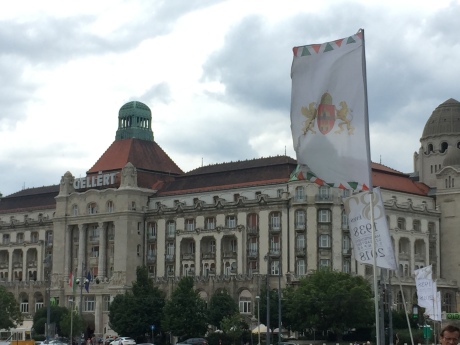
One memorable side trip was an evening guided boat cruise down the Danube. The shimmering city lights played off the water, creating a magical setting as we glided past historical bridges and buildings lining the shore.
What we ate: What we drank:
Our first night in Budapest, most of our group walked around the corner and up a narrow residential street to the Black Raven Restaurant (Fekete Hollo), the oldest restaurant in the Castle district, established in the 17th century and rebuilt in 1970. The restaurant’s history claims their food is reminiscent of King Matthia’s time, when paprika was not the favored spice it is now. I have consistently had Hungarian paprika in my refrigerator from my early days of cooking, available to season chicken paprikash, sprinkle over deviled eggs, or flavor roasted poultry. I couldn’t wait to savor their chicken paprikash and cucumber salad to see how mine measures up. They were as delicious as expected and quite similar to mine. Russ had French onion soup and veal schnitzel. We enjoyed a 2013 Fantastico Malbec from Argentina., which Russ described as similar to a heavy bodied merlot that enhanced our meals without overshadowing them.
My daughter, Gabrielle, had been to Budapest the year before and had highly recommended Pest-Buda Hotel Bistro’s food. Fortunately for us, it was a two-minute walk from our hotel. The food and boutique quaintness of the café were so delightful, we ate lunch there one day and dinner the next. My confusion at our waiter’s broken English recommendation caused me to order a catfish paprikash meal with homemade cottage cheese pasta that I would otherwise not considered, but was elated with the results. The pureed catfish inside the cabbage roll was a light, delicate flavor and sat on a bed of the homemade cheesy pasta. Diced bits of crisp salty bacon and a tart dollop of sour cream made every bite a new experience. Russ ate a Hungarian pizza (yes, that’s what it’s called). Basically, it’s a flatbread coated in sour cream and bacon, which made it succulent but not soggy, with no one flavor being overbearing. He drank Fóti Kézműves Sörfőzde beer, a premium lager craft beer. I drank Vámos Attila Syrah ’13, a dry red wine from the Eger region. It had a bit of a bite, but a lingering finish that allowed my catfish stuffed cabbage to shine. The next night we returned shortly before 6, not knowing that Peat-Buda Bistro doesn’t officially open until then. As the bistro is small and quite popular with locals, we wanted to be sure we could get in. By 6 pm, the restaurant was already packed, but not one order is taken until promptly at 6. Russ ordered his same pizza. This time I had traditional Hungarian stuffed cabbage, which uses pork and rice filling with sauerkraut on top instead of the Romanian style I grew up eating with hamburger, rice and chopped cabbage. I was married to a Hungarian who passed away quite young, and learned to make the Hungarian version at that time. We both drank the same alcohol as lunch the day before, and I also had a large market salad of greens (like arugula), radish slices and tomato.
Before leaving for this trip, my friend Zita said, “You must eat at Rosenstein Vendeglo Restaurant, “My favorite restaurant in Europe. And have the roasted goose leg.” Much to our pleasant surprise, our Odysseys Unlimited hosted dinner was there and the goose leg was one of the options. I’ve never eaten goose but after Silvija also highly recommended it, I eagerly awaited my meal. Rosenstein’s is a prominent family-run restaurant whose extensive menu has been dedicated to classic Hungarian and some Ashkenazi Jewish dishes for the past 50 years. The goose leg, a tad smaller than a turkey leg, was juicy inside and crispy on the outside. It was plated with red cabbage and mashed, lumpy seasoned potatoes. I stuffed myself contentedly. Russ had a veal paprikash dish with homemade egg noodles they call dumplings. In Germany, this style of dumplings are called spatzle. Dessert (which I barely tried after not being able to eat even half my goose) was Arangaluska, a traditional dish of sugary balls of coffee cake dough studded with raisins and coated with cinnamon and nuts in a syrup-like glaze on the outside.
OTHER HUNGARIAN STOPS ON THE ROAD TO VIENNA, AUSTRIA
Szentendre, a small riverside town on the Pest side of the Danube Bend, was an immediate hit with anyone looking to buy handmade souvenirs, clothes, and kitchen cloths not seen in city shops. We first visited the Margit Kovacs Ceramic Museum and gift shop before shooting out the door to admire this charming small town in the hour we had. Immediately in front of us, strings of colorful and uniquely decorative lamp shades are strung like Christmas lights over the intersecting streets of the town. For Russ, this will be the town he won’t forget. For years he has looked in stores, catalogues and specialty shops wherever we’ve travelled for a pair of gloves for shooting sporting clay and skeet. He has very clear needs, including smooth finger tips unlike the thick sewn fingertip edges universally found. He walked into Retikul, a family-owned specialty glove and handbag shop, which actually makes the gloves, and found his perfect fit.
Just as special as finally finding his gloves was to Russ, our next stop was a highlight for me to learn we’d be having a strudel and goulash soup cooking class and lunch at Dunaalmási Lovarda, a Hungarian farm that also hosts youth camps and raising horses for rehabilitation therapy. I learned the fine art of strudel making at a young age, taught by my Aunt Golda, an outstanding baker on my Dad’s side of the family. I remember clearly being instructed that the dough had to be rolled out paper thin. Nowadays, that’s more work than I care to do and have taken to less complex methods, but I couldn’t wait to be reacquainted with traditional methods.

Traditionally-clothed workers preparing goulash soup served in homemade breadbowls at Dunaalmási Lovarda.
What a charming rustic farm. Wooden picnic tables sit under a wooden canopy next to the field where horses are trained and dogs yelp at their legs. The workers wear with traditional garb of patterned aprons and hair-covering babushkas (scarves). We were welcomed with a glass of sparkling wine, then encouraged to both taste and help roll out a flat bread called Lángos (very similar to a flattened pita bread) before sliding it in and out of a hot pizza oven. Then we divided into two groups to try our hand at making strudel, carefully using a thin tablecloth to turn the apple-topped paper-thin dough into a jelly roll shape before placing it in a ceramic dish in a u-shape. While the strudel baked, we dined on goulash soup served inside a freshly-baked bread bowl. Local red and white wines accompanied our soup. By then, the strudels we supposedly made as well as two other types, were cut up on a platter and set on the tables. My favorites were the apple and the cheese strudels.
Fully sated (and likely high on sugar), I eagerly awaited sampling Austria’s strudels for comparison.
Coming in Part 4 – The Music and Muses of Vibrant Vienna
www.hilton.com
www.matyas-templom.hu/
www.greatsynagogue.hu/gallery
www.treeoflifefoundation.org
www.gellertbath.com
www.feketehollovendeglo.hu
www.pest-buda.com
www.rosenstein.hu
www.fotisorfozde.hu
www.szentendre.hu/
www.muzeumicentrum.hu/en/kovacs-margit-ceramic-museum
www.dunaalmasilovarda.hu
Karen Kuzsel is a writer-editor based in the Orlando area who specializes in the hospitality, entertainment, meetings & events industries. She is an active member of ILEA and MPI and is now serving on the 2017 – 2018 MPI Global Advisory Board for The Meeting Professional Magazine for the third consecutive year. She is a member of the Society of Professional Journalists. Karen writes about food & wine, spas, destinations, venues, meetings & events. A career journalist, she has owned magazines, written for newspapers, trade publications, radio and TV. As her alter-ego, Natasha, The Psychic Lady, she is a featured entertainer for corporate and social events. karenkuzsel@earthlink.net; www.ThePsychicLady.com; @karenkuzsel; @thepsychiclady. Food photos for this series by Karen Kuzsel.
All other Photos by Russ Wagner, a retired government planner/builder who has a passion for trains, travel and taking photographs.


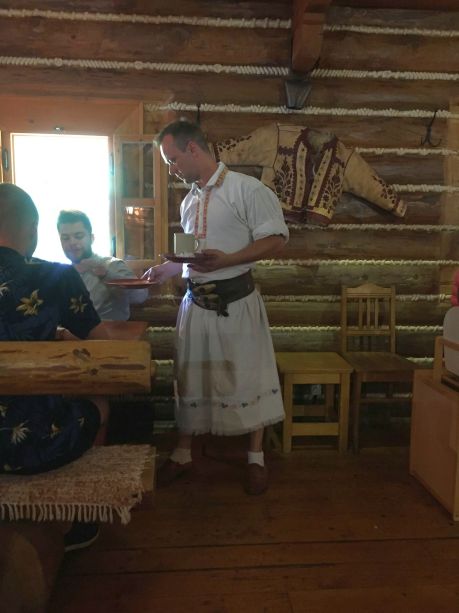



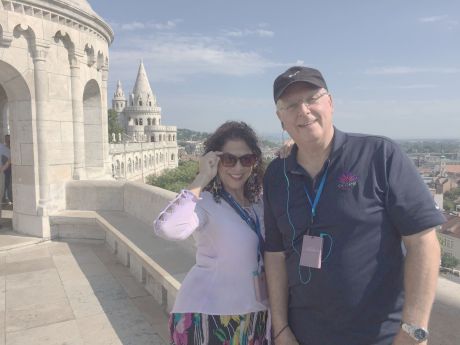



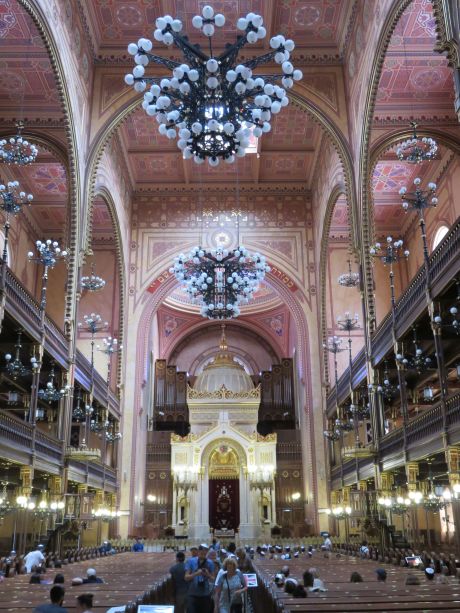

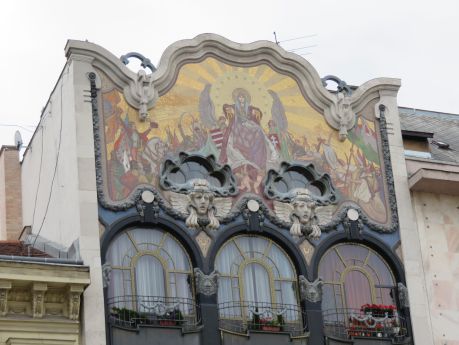
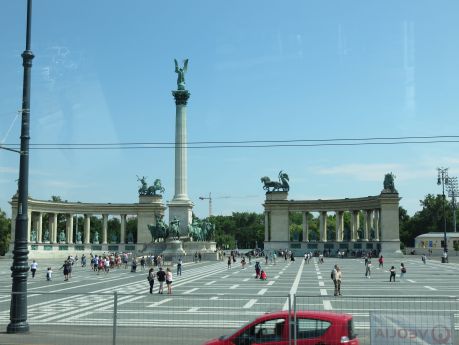
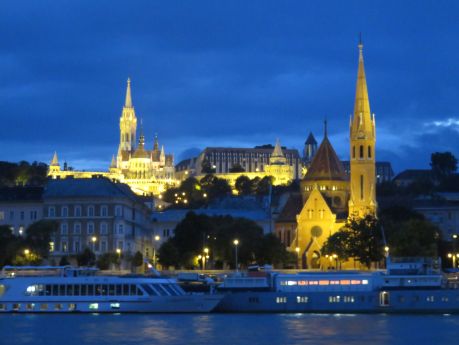

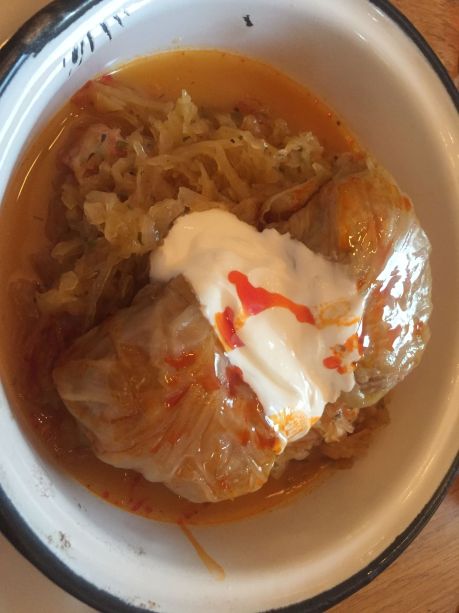
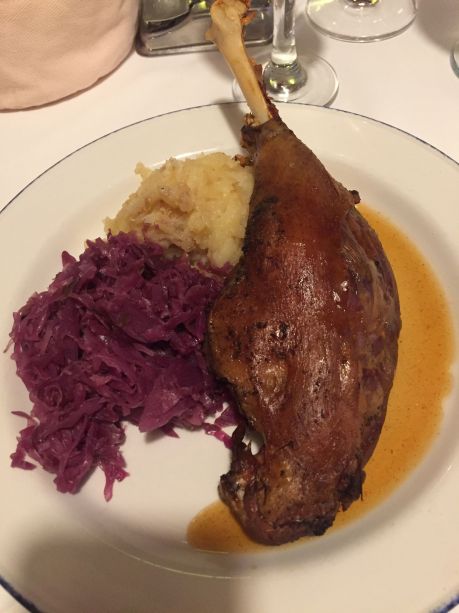
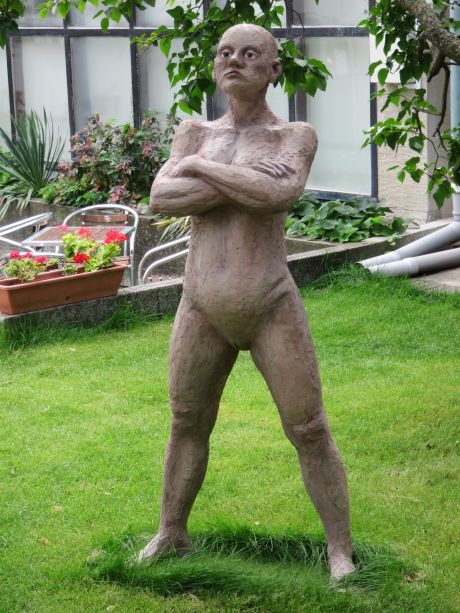
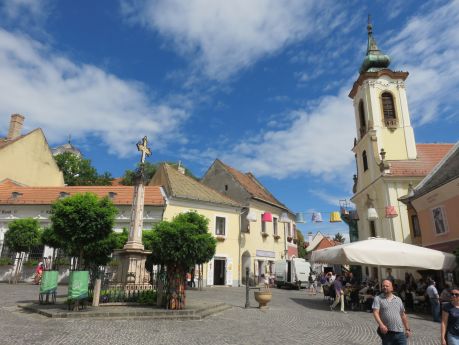
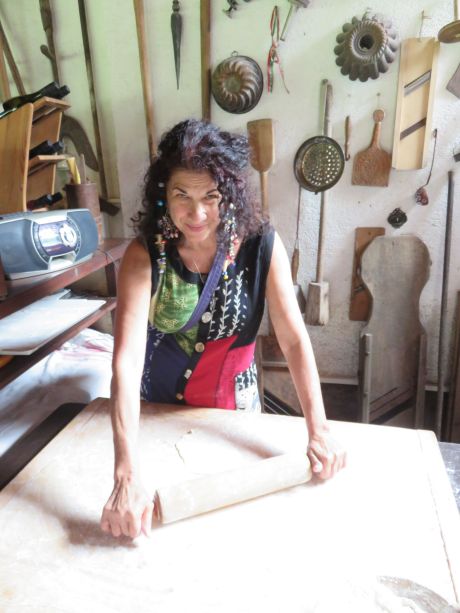
This is so refreshing and educational. Thank you.
What I Learned
Everything. I am still in awe. It was interesting to learn that a swim cap is needed to swim in the unheated pool. I thought that, aside from me (to avoid getting my hair wet), only professional swimmers wore those.
What I Saw
Russ wearing an Ocoee, Florida shirt on Buda Hill. 🙂
What I Loved
Everything – the vivid descriptions, the beautiful, captivating photos, the history, the travel tips… I experienced everything with you, especially the strudel and goulash soup cooking class at the Hungarian farm.
Rhonda,
You make my heart sing to know you thoroughly read and savor my travel blogs. Russ laughed about you recognizing his Ocoee shirt. Budapest and all of our stops in Hungary were probably my favorite. For him, as you will read soon, Vienna was a standout. Glad you got to have a “taste” of apple strudel!!!